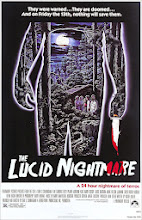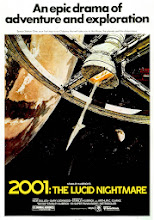Paprika
Director: Satoshi Kon
Year 2006
Paprika is one hell of a trippy film. It's so trippy in fact, that it could literally give you nightmares for weeks. Directed by Satoshi Kon, who just so happens to be one of the greatest animators of recent times, creates a world where dreams can be experienced and shared by others, allowing for a whole new world of interactive possibilities in a new high tech civilization. Kon's credits include some of the best animated films in the business like Perfect Blue, Tokyo Godfathers, and he's responsible for the writing credits for the stupendous short story Magnetic Rose which can be found in the anthology Memories, that I reviewed here on this site.
 |
| I can feel your beady little eyes watching me. |
Satoshi Kon is also known for the animated film Millennium Actress which I recently picked up for a bargain and have yet to view. Odds are that I'm really going to enjoy that one. Needless to say that the man is a legend and has contributed so much in the animation world, but sadly he passed away this past August, leaving behind a legacy that will most definitely stand the test of time. His films seem to have a life of there own and this outstanding quality is perfectly displayed within the vibrant story of Paprika.
 |
| Party People! Party People! |
The premise for this little animated gem is quite intriguing and ever so ambitious. Satoshi sets up a world that is not much different from our own. It's a place filled with ordinary people who love movies, work jobs, and have dreams. What makes this world so unique from our own though, is the invention of a device that can record a person's dreams, giving way to a whole new voyeuristic obsession. This magnificent device, called the D.C. Mini, is used in the practical and professional field of psychiatry, particularly by therapists as they delve into their patients minds to work out the mental kinks and unveil a whole new layer of the mind's inner workings.
 |
| So how did all of this porn get on your computer? |
The problem with creating such a powerful device is that it's bound to be exploited and misused. The D.C. Mini is stolen from the Foundation for Psychiatric Research facility and is now being used by a recluse assassin who uses the device to enter his victims dreams in order to plant his own nightmarish visions into their world. This vision which at first seems to be a harmless parade of oversized teddy bears and cute smiling figurines, quickly begins to turn ominous as they threaten to overtake anyone in their path, both conscious and unconscious. The plot is simply amazing and seems like an inspirational stepping stone for Christopher Nolan's masterwork, Inception. Both deal with the idea that our minds are an intricate labyrinth that can be beautiful, but at the same time very deadly.
 |
| When the trust game goes too far. |
With such a rich and interesting concept ripe with possibilities, Satoshi does not disappoint by using the idea of dream manipulating to its fullest. There's always a new twist or turn in the story-line that keeps things interesting, all while at the same time he lays out the possibility of what would happen if such a technology existed. Dealing with dreams, both conscious and subconscious, Satoshi plays with the notion of never letting the audience know if what they are seeing is truly real or a figment of someone else's demented imagination. The nightmares that spill out onto the screen are some that are strikingly real and obscurely out of this world.
 |
| Man she's got some self image issues. |
There are many familiar and stereotypical visual cues that seep there way into the many dream sequences that fill this film. One of the most recognizable ones is the old running in slow motion or the feeling of running in place, not being able to get away or take chase. Satoshi uses these conventional ideas and builds off of that to really make these surreal sequences hit home for the audience. For example, one of the main characters, a detective, is experiencing a reoccurring dream, that has him chasing an assailant down a long hallway, only to be foiled by the very ground that he walks on. It wavers and pitches like a tidal-wave as he helplessly watches his intended prey vanish out a fire escape. This example is just one of many where Satoshi uses the inherent notion of dreams and builds upon it, to make a very chilling and effective sequence.
 |
| Get moving there crazy legs. |
There's also a great blending of filmic iconography throughout the film. The same character that was having the reoccurring nightmare of not being able to catch his suspect, has a panic attack whenever anyone mentions the cinema or films in general. This fear is then translated over to his dreams, where he is forced to act out iconic scenes from various films, as he falls from one genre to the next. The later reveal in the film, explains why he is so disturbed by filmmaking. It's actually an emotional story that gives the character an extra layer of sympathy and life. It's also nice to see the use of all of these cinematic elements, because it really works well with the idea of dreams and it shows the great love that Satoshi had for motion pictures and the power that they can possess.
 |
| And you thought your movie theater was filled with assholes. |
The concept of being able to experience other people's dreams is a fantastic idea, and one of the great things about working within that mind of thinking is to be able to conceptualize some over the top sequences that are able to really astound the mind. The entire plot is guided by this unrelenting notion that the character's wildest dreams are at the controls, plotting our course wherever their mind will take them. It's a place where anything can happen and the laws of physics and overall restrictions that the real world hinders onto us is thrown right out the window. Some of the scenes that Satoshi comes up with are just stunning in there execution and breathtaking in how visceral such a fantasy infused idea can be.
 |
| I believe I can fly. R Kelly inspires! |
The very idea that a device can make it possible to enter someone's dreams and give the user the ability to infect another's mind is something that's truly exceptional and full of promising possibilities. What's even more wondrous is the fact that as the plot thickens we find that not only can this infection occur between one person to another, but it can begin to infect an entire population. This cascade effect can reverberate like a snowball rolling down a mountainside as it gains momentum and begins to collect mass growing larger and larger as it continues on. I love the concept and it's visually displayed to perfection as a large bombastic parade that walks the streets of the city, collecting people up as it goes. The scenes where this massive parade of people shows up is really something from out of a nightmare. It's cute and filled with oddities, but infectious and down-right destructive.
 |
| Godzilla vs. Naked Tar Man |
With such ambitious concepts that are brought forth by the film's story, Satoshi is more then up to the challenge in rendering an equally elaborate visual style that can bring all of these ideas to life. The worlds and characters that spring forth from these dreams are matched only by their natural progression of fleeting appearances and disappearances. Much like a dream, things happen and then fade in an instant, only to never return, even without explanation. You would think that this would make the overall story seem pretty frantic and nonsensical, but luckily Satoshi is a master story teller and is able to balance the confusing nature of dreams and give it some substance, even if it is in some form of metaphor or personification of the overall idea. Paprika is a deep piece of work and one that demands a great deal from its audience.
 |
| Do you have an old asian in you? Do you want to? |
I've been fairly vague in my description of this film and that is entirely on purpose. Paprika is a movie that you should go into with a moderately fresh mind, just be prepared to be blown away. It has some ambitious ideas and even more impressive visuals that ask a lot from the viewing audience. The concepts are fierce and if you don't pay attention, they can threaten to swallow you up, much like the infectious parade of cute and fuzzy party goers.
Paprika is an outstanding look into what a dangerous place our minds can be. The reality that ideas are born from our own intentions but can rapidly turn into something else entirely, haunting us and changing our conscious decisions, is a frightening one. The way that Satoshi introduces this concept through the terroristic actions of a rogue assassin, misusing a new and powerful technology, is genius. He takes us on an amazing ride that defies logic yet sits it casually within the realm of possibility. I highly recommend this film to animation lovers and anyone who dares to dream about something bigger then themselves.
5 out of 5 stars A Masterful Dream-Manipulated Epic!



























































































Just finished watching this film and I couldn't agree more. The ending of a truly overwhelming film is so easy to feel but at the same time so rare. My only piece of advice would be don't question anything in the film till it's over, just follow it.
ReplyDeleteI believe the real skill to the film is how easy to relate to it is. Everyone has had the recurring dream before in their life. It's possible to sympathise with the chairman and the lead characters.
Easily the best anime feature since Mayazakis Spirited Away and conceptually the best anime since Death Note. Easily the best film I've seen since Slumdog Millionaire or Pans Labrynth.
The easiest most western description I could give is Amelie meets Inception.
5/5 must see